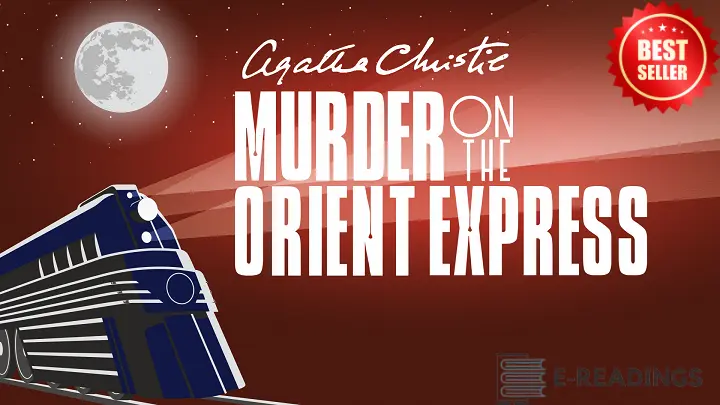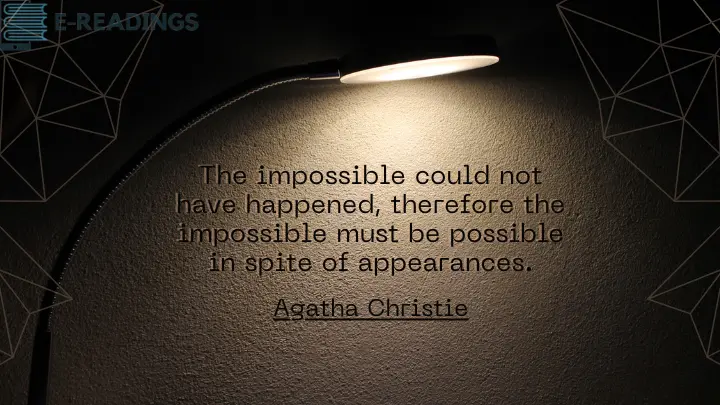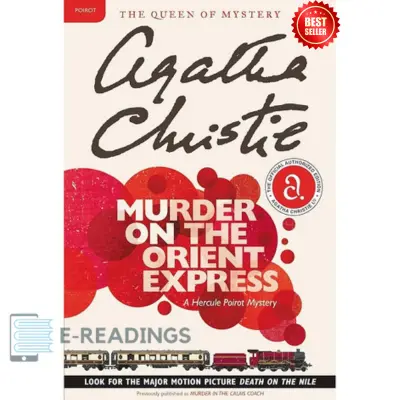Agatha Christie’s “Murder on the Orient Express” was my gateway into the world of her unique brand of writing. The first-time reader of Christie’s work finds this literacy discovery interesting. Christie’s attention to detail and his well-placed words with their smooth rhythm create a story that keeps you hooked from beginning to end. The excellence in plotting, cohesion, and conciseness can be seen all through her brilliance. In this regard, the murder mystery stands as a testimony to Christie’s prowess in keeping readers captivated, such that one cannot put down the book until the very last revelation has been uncovered.
Murder on the Orient Express by Agatha Christie Review:
Murder on the Orient Express was published on January 1, 1934. A classic murder story was written by Agatha Christie. It’s a journey I will never forget as he was published in 1934. However, shortly after boarding the luxurious Orient Express, my mundane adventure turned into a captivating investigation as I uncovered the horrific murder of an American passenger, Ratchett, who was found dead in his compartment.

My clever deducing skills, intricacy of characters, and ingenious plot twists make it an excellent novel. The plot was full of intricate threads that left readers guessing at everything up to the last minute. “Murder on the Orient Express” is more than a story; it is a show of my power of narration and building of tension. It deserves, indeed, one of my greatest successes in this field and criminal literature.
Theme:
Agatha Christie’s works often revolve around similar issues. For example, in “Murder on the Orient Express,” I, Hercule Poirot, have a storyline with those same themes.
Justice and Morality:
As I struggle with a crime that goes against established norms, I question mainstream notions of justice and morality. The resolution forces the readers and characters to examine the moral ramifications involved.
Revenge:
My plot is that of a revenge storyline as I find out Mr. Ratchett’s hidden sins leading to the infamous event referred to in this paper. This investigation looks at vendetta as an ending and resultant, presenting credible characters with layered motives. And through my ability to reveal their different origins, my story becomes even deeper.
The Cost of Truth:
Hercules Poulet, face a moral dilemma, trying to uncover the truth and raise questions to myself regarding the sacrifice it involves.
Isolation and Confined Spaces:
The tense mood is greatly enhanced by the location of the Orient Express as it rushes through a white landscape. Suspense is generated through our confined surroundings wherein we trap characters together.
International Relations and Prejudice:
It captures an international context with a diverse cast of characters from many countries. In this novel, there are issues to do with racism and stereotyping as people make decisions based on nationality and culture.
Main Characters:
Murder on the Orient express characters different origins, nature as well and secretive side. Let me introduce you to some of the key players in this intriguing tale:
- Hercule Poirot: I am a renowned Belgian detective with keen observational and logical skills. I play the main part as an investigator in this interesting narrative.
- Monsieur Bouc: He is a friend of mine and the director of the Orient Express who gets involved in the investigation and helps me solve the riddle.
- Ratchett / Cassetti: The original name of the killer was Ratchett, but it turned out that it was Cassetti, a famous brutal criminal who had committed a terrible crime.
- Mary Debenham: Sheila is described as being a “mysterious and reserved” British governess who subsequently becomes a prime suspect in the murder case. During my investigation, I delved into her relationships with other passengers.
- Colonel Arbuthnot: Another suspect is a retired British Army officer. I examine his history and examine how he intertwines with the other characters and establish the importance of these relations to the story.
- Mrs. Hubbard: An emotionally charged and dramatic widow from America who gets into investigations and thus complicates the story.
- Princess Natalia Dragomir: A formidable old Russian aristocrat, providing a dash of nobility and international spice to the storyline.
- Greta Ohlsson: A Swedish missionary who is calm and collected joining investigations.
- Countess Helena Andrenyi: A Hungarian countess and suspect. In the course of investigating, I came to know about her aristocracy and who she belongs to.
- Hector MacQueen: A crucial character who plays a pivotal role in the solution is Ratchett’s secretary.
- Michel (the conductor): A conductor of the Orient Express who helps me with investigations.
- Antonio Foscarelli: A suspected Italian chauffeur. Throughout the entire narrative, I look into his history and social life.
Historical Context of Murder on the Orient Express:
This is how “Murder on the Orient Express” begins, taking place in my familiar environment – the 1930’s which was mine as well when I wrote it off in 1934. The narrative encapsulates the essence of that period, marked by significant historical events and societal shifts:
- Interwar Period: The setting of the novel is during the period which falls within two World Wars which was influenced by several factors in Europe.
- The Golden Age of Travel: The Orient Express is the main element here depicting luxury and refinement of the old world. It further adds a sense of luxury and mystery to the story since it was one of the most popular elite modes of movement between Europe’s prominent towns.
- International Relations: A wide array of characters from different nations is a testimony that the journey of Orient Express is an internationally recognized tour. Point The complexity of character interaction is further accentuated by the turbulent political tensions and diplomatic subtleties of those times.
- Influence of Art Deco: The tale takes readers into the swanky context of the Orient Express, resembling the spirit of the 1920s and 1930s as it embraced the bold geometric forms and rich decorations of the Art Deco period.
- Rise of Detective Fiction: Detective fiction remained on an upward trend during the 1930s. Murder on the Orient Express is an example of such works that show the importance of detective fiction for which I was among esteemed authors like Arthur Conan Doyle and Dorothy L. Sayers who together shaped the conventions of the genre during that era.
Famous Quotes:
The Quotes in this book present the character; the mystery and the detective work by Hercule Poirot. Here are a few notables.
Hercule Poirot on His Abilities:
Sometimes, I was uncontrollably, severely pained by sorrow, however, despite everything, I am sure that being alive is a marvel.
Hercule Poirot on Justice:
“On the nose. It is the brain, the small gray cells that are necessary. Within—not without.”
Monsieur Bouc on Poirot:
“You’re mad, Poirot, absolutely mad!”
Poirot responds: However, on this point, you do not understand, I am both mad and right. As for the point on which I have proved my truth, I have found the truth.
Hercule Poirot on the Solution:
“Because it is not true that nothing happened, the impossible should also be possible despite all appearances.”
Hercule Poirot Reflecting on Justice:
“My dear Miss Debenham, there are some offenses which don’t look very much unlike crimes… Avoid being misled by outward appearance if I were one of the criminals, I would be the worst criminal in the world.”
Princess Dragomir’s Observation:
“Instinct is a wonder! You cannot explain it, you must not ignore it.”
Mrs. Hubbard on the Murder:
“Who does it” …. “Hercule, I know who did it. I shall tell you later”.
Hercule Poirot on Morality:
Mademoiselle! I do not like killing people because it is a sin and contrary to the law of nature

Hercule Poirot Series in Order:
My “Hercule Poirot” series includes “Murder on the Orient Express”. While my works primarily consist of standalone novels, each featuring a self-contained mystery, I’ve crafted a list that might help you explore more of Hercule Poirot’s intriguing cases:
- “The Mysterious Affair at Styles” (1920): A story of the first detective novel about Hercule Poirot— a Belgian detective and his friend Captain Arthur Hastings.
- “Murder on the Links” (1923): I am called upon to deal with a murder case of a wealthy industrialist at a French golf court
- “Poirot Investigates” (1924): The Murder of Roger Ackroyd by Ariadne Oliver, a short story collection featuring Poirot and their sleuthing abilities
- “The Murder of Roger Ackroyd” (1926): This is my most famous novel that has an innovative plot twist.
- “The Big Four” (1927): The crime syndicate is an influential and hidden institution that presents me with an impossible challenge.
- “The Mystery of the Blue Train” (1928): At the time I was carrying out investigations into a murder while on a luxurious train.
- “Peril at End House” (1932): I help guard a teenage girl who appears to be at the focus of several attempted killings.
- “Lord Edgware Dies” (1933): My investigation is centered around the murder case relating to a rich lady called Lady Edgware.
- “Murder on the Orient Express” (1934): The renowned novel wherein I resolve a homicide on the posh Orient Express.
- “Three Act Tragedy” (1935): I explore a string of deaths that seem not to be connected at all.
- “Death in the Clouds” (1935): My work is about a murder that happens in an aircraft and me.
- “The A.B.C. Murders” (1936): I look into a string of murders listed in alphabetical order.
- “Murder in Mesopotamia” (1936): I am investigating a murder in an archeological expedition in Iraq.
- “Cards on the Table” (1936): A murder takes place at a dinner where I am invited.
- “Dumb Witness” (1937): Case of a murdered rich woman which I’ve solved.
FAQ:
The movie “Murder on the Orient Express” was penned by.
The novel, Murder on the Orient Express, was written by Agatha Christie.
What year did “Murder on the Orient Express” come out?
It was initially published in 1934.
Which detective plays a central role in the plot?
The lead detective in this story is Hercule Poirot.
What is the main storyline in “Murder on the Orient Express”?
Murder on the Orient Express- in this novel, a wealthy American known as Ratchett is murdered on board the express while Poirot helps to unmask the murderer.
Why is the Orient Express in the story?
This novel is set on the Orient Express; a high-end train that travels from Istanbul to Calais in France, the location of the crime.
Conclusion:
Therefore, at the end of “Murder on the Orient Express,” Hercule Poulet gives two explanations to the police. The last one is a classic justice but, it exposes their shared duty in bringing vengeance for Daisy’s death. Alternatively, it could be a cover-up of the crime for the sake of society. At this point, out of wisdom, the authorities choose the first option since the passengers face legal consequences.
In the last scene of the novel, however, I keep thinking about the gray nature of this action. Its surprising but morally challenging nature makes it a subject of intense discussions on ethical and moral issues surrounding justice. This is what makes “Murder on the Orient Express” one of my greatest detective’ stories.
